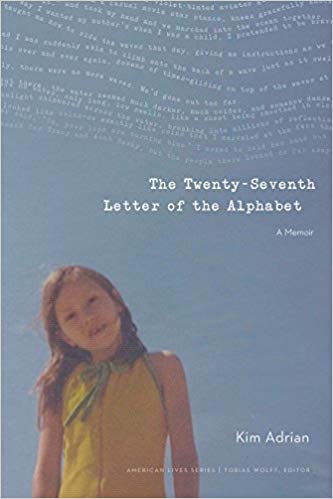 Kim Adrian’s past simultaneously haunts and fascinates her. She has spent years excavating her memories and the photographic archives of her family’s history, and though she recalls many intricate details, piecing them together in a way that makes sense continues to elude her.
Kim Adrian’s past simultaneously haunts and fascinates her. She has spent years excavating her memories and the photographic archives of her family’s history, and though she recalls many intricate details, piecing them together in a way that makes sense continues to elude her.
In her memoir, The Twenty-Seventh Letter of the Alphabet: A Memoir (University of Nebraska Press, October 2018), Adrian uses a highly unconventional form to mirror her confusion over how to connect her wide-ranging, frequently painful memories of what she and her sister endured living with a mentally ill mother and an alcoholic and violent father.
Adrian writes her memoir as a glossary, starting with A and sharing her story though short vignettes represented by words for each letter of the alphabet. The resulting book is really the story of Adrian’s relationship with her mother — of her continual search for explanations for her mother’s behavior, and the impacts her mother’s mental illness had, and continues to have, on Adrian’s identity.
“The dominant emotion I hold in my heart (or whatever somatic port emotions actually reside in) for my mother is a complex thing: tender and living, destructive, oppressive,” she writes. In many ways, the glossary format of the book — presenting the story in fractured and out-of-order pieces — echoes the non-linear nature of a mentally ill person and their family struggling to understand the world around them, and to survive in it.
Despite the heartbreaking pain of the stories Adrian shares, she remains clear-eyed about what she remembers, providing minute details in ways that bring her scenes to life while also creating deep connections between the reader and her childhood self. In a scene where she watches her drunken father brutally beat her mother, Adrian tries as hard as a young girl can to intervene. Eventually she does get between the two of them, and her father shoves her out of the way.
Her only subsequent memory of the scene is of a hammered copper hinge, part of the cabinet under their kitchen stove, next to where she fell. “Even now, in memory, it remains spectacularly in focus: tarnished and spade-like, it is full of tiny, shallow divots,” she writes. “A fine line of grime runs around its edge.” The reader is right there with the little girl, who is trying to understand what is happening in the moment, and with the adult narrator, still struggling years later to deal with the trauma.
The glossary format doesn’t always work — sometimes the vignettes, which frequently jump around in time—can be a bit confusing as the reader attempts to understand which timeline they are in. Additionally, Adrian writes many vignettes describing family photos, and it would have been nice to actually see some of the photos included. However, the beauty of Adrian’s prose, and the courage she exhibits in telling her story, make it easy to overlook some of these flaws.
Despite everything, Adrian still loves her parents. By sharing her conflicted feelings in such an intimate way, she helps the reader see not only that love, but its indelible impact on the identity of a woman still wrangling with how to define it.
 Sarah Evans is an Oregon writer who has been published in Mom Egg Review, River Teeth Journal’s Beautiful Things blog, and Brevity’s nonfiction blog. Her work is included in the new writer’s guide and anthology, “Short-Form Creative Writing.” She earned an MFA in nonfiction writing from Pacific University. Read more about her at www.sarahevanswriter.com.
Sarah Evans is an Oregon writer who has been published in Mom Egg Review, River Teeth Journal’s Beautiful Things blog, and Brevity’s nonfiction blog. Her work is included in the new writer’s guide and anthology, “Short-Form Creative Writing.” She earned an MFA in nonfiction writing from Pacific University. Read more about her at www.sarahevanswriter.com.


